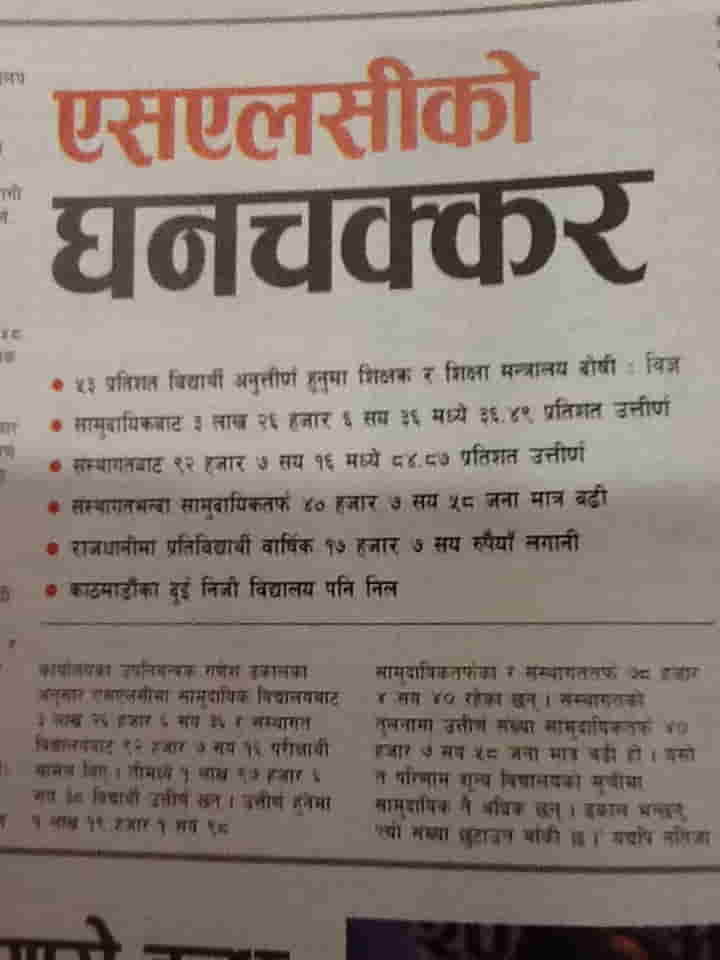Today, March 14, 16-18 year-olds in Nepal who made it all the way to 10th grade will be taking their SLC (School Leaving Certificate) examinations.
After getting over some major hurdles and making it all the way to tenth grade, SLC, essentially high school diploma exams, make or break their academic careers, and, for many, their lives! Those that fail have very very few alternatives. Nepal has no vocational or technical schools of any kind that I know of. The examination statistics, however, paint a sad, very sad picture of the state of secondary education in Nepal!
The year I took it, in the late eighties, only 25% passed it!
Last year’s results (2068/2012) are much better but still not good enough. A total of 495,998 students took the exam. Out of those, 419,019 were regulars, meaning this was the first time they were taking it, and 76,979 were exempted candidates, those retaking it for the second time.
A passing rate of 47.2% means that more students failed than passed! They could, of course, retake them but going by the pass rates of the exempted candidates last year, the chances of passing it is even smaller. Only 13.8% of the exempted candidates passed it!
If that isn’t appalling enough, the difference in the pass rates of students from urban centers, attending expensive private schools and those who attend government school, whether in urban centers or the countryside, is just horrendous. The photo below, that of a part of an article in a newspaper, contains the summary.

Here’s a translation of the bullet-point summary:
- Teachers and the education ministry to blame for the 53% failure rate: analysts
- 36.49% of 326,626 candidates from government/community schools pass
- 84.87% of 92,716 candidates from private schools pass *
- Only 40,758 more students from government/community schools than from private schools pass
- In the capital, government invests Rs. 17,700 (approximately US$203 at US$1.00=Rs 87.00) per student per year in government schools
- Two private schools recorded a 0% pass rate
(* The total numbers don’t add up! According to my first source, the total number of regular candidates was 419,019, but according to this source, it is 419,342!)
An overwhelming majority of students attend government/community school which are under-funded and under-resourced. Most students from low socioeconomic backgrounds whether living in the countryside or cities, don’t have a choice–it’s either no school or a government school. But, with an average investment in education amounting to less than US$20 per head per month in Kathmandu (and probably much less in rural schools), theses students are set up to fail even before they begin. Only about one out of every three that make it all the way to 10th grade get their high school diploma.
Those that attend private schools, those who are wealthy and live in urban centers, almost 9 out of 10 graduate.
For a large majority of marginalized youths of Nepal, a high school diploma still does not assure them of a decent future, academic or otherwise. While I was growing up, the only option for intermediate level studies was the government colleges, run by the one and only government university, Tribhuvan University. I described elsewhere how further education at intermediate level government colleges was more about politicking than teaching and learning.
The situation now is a little different. Private colleges are abundant, but mostly in Kathmandu. They are however expensive. Some colleges do offer scholarships to students who have performed very well in SLC, i.e. not necessarily those from low-income families.
More and more of those disenfranchised youths, unable to continue with their education, go abroad as semi-skilled or unskilled laborers. According to the latest census data (of 2011), every fourth household in the country had at least one member of the family either absent or living abroad, totaling a little over 1.9 million. Furthermore, almost every other person abroad was reported as being between the ages of 15 and 24. In other words, almost a million 15-24 year old are not living at home. Knowing the number of airlines and frequency of flights operating between the Gulf region (Abu Dhabi, Dubai, Doha) and Kathmandu, and having flown that sector almost every couple of months for the last 20 months, I can tell you that most of these youths end up here in the Arabian Peninsula…out of sheer desperation.
To be sure, apart from pedagogy and resources, there are a number of other reasons for the abysmal SLC performance. Additionally, again to be sure, the inept and corrupt politicians and leaders in the country are partly to blame. After 22 years of “democracy”, all indications are that they have no interest in solving any real problem, or addressing any real issue, of any import to the nation and the people. And further, to expect them or hope for them to do so would be akin to waiting for tomorrow to come!
